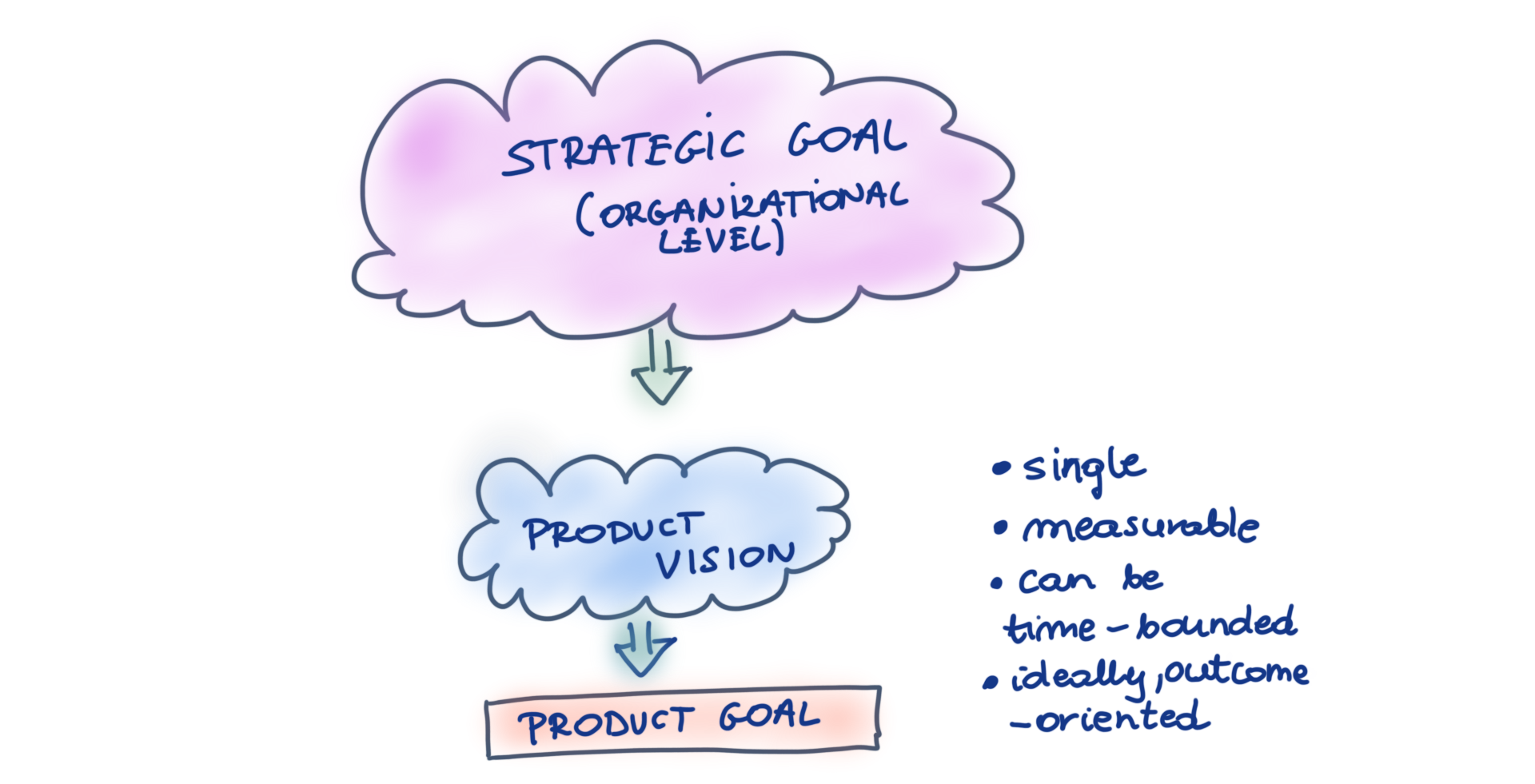
Product Goals were added to the 2020 version of the Scrum Guide. The idea of incorporating this concept was to emphasize the importance of having a longer-term goal than a Sprint Goal.
The Product Goal is a reflection of the product vision, the bridge between Sprints and the vision. Besides, many Product Owners used Product Goals before the Scrum Guide updates. We may say that the usage of the Product Goal has been observed in practice for years in Product Management.
Product Goals are reflections of the Strategic Goals (organizational level) and, as mentioned before, the product vision. Product Goals can be considered as Intermediate Goals.[1]
Goal-oriented organization & teams
The concept of goals is nothing new in Scrum. Organizations have been using goals successfully for many years to deliver their strategies. The Scrum framework emphasizes the importance of goals. Moreover, based on my experience working with a large number of companies over the years, I noticed that even if the organization is aware of the goals in general – in fact, they don’t use them.
Plenty of research on self-managed, goal-oriented teams shares that:
- Goals give focus
- Knowledge integration
- Teams’ effectiveness [2]
Commitment to the goal gives teams intrinsic motivation. Be careful – multiple objectives create confusion for a team.
So, why are goals still omitted in organizations? Reasons may differ. In general, setting up goals is difficult in some cases. The situation becomes even more complicated if we add the necessity of having measurable goals.
In addition, sometimes, goals do not reflect the real organizational opportunity in the market. The focus is on something different than the current customers/users’ needs or changes in the market.

What happens if you choose the wrong goal?
The short answer is: you will lose time and money.
Based on my research [3], organizations are afraid of changing their strategic and product goals. It might be related to emotional attachment to the objectives they created. World and needs are changing while goals remain the same. Goals can be changed or updated if the current situation has evolved.
So, what to do to feel more confident in setting strategic and product goals?
Use empiricism to set and achieve strategic and product goals!
- Unrealized value. Search for goals in the Unrealized Value area. What are our customers’ or users’ satisfaction gaps? What are market opportunities?[4]
- Make your goal measurable. Focus on outcomes, not outputs.[5]
- Establish the cadence. How often should we verify our progress?
- Measure on this cadence. What measure would help us ensure that we’re moving in the right direction?
- Inspect and adapt based on facts. Alright, now we have data. What have we learned? What should we change?
- Mind leading and lagging indicators. Which measures lead us to our goal? Should we change them if we do not observe any progress?
- Adapt goals when needed. OK, the market situation (or the organization) has been changed. Let’s update our goal.
Setting up the right goal
First, ask yourself these questions:
- How can this goal help us?
- How do we know if our goal is accurate?
- How would I measure it? How do I know when I will reach this goal?
Take a look at my example of a Product Goal:
WE WANT TO IMPROVE OUR PRODUCT (courses) SO THAT OUR CUSTOMERS ARE MORE SUCCESSFUL IN ACHIEVING 25% MORE MOTIVATION TO LEARN NEW THINGS AS DETERMINED BY:
- GENERAL SATISFACTION FROM THE COURSE- 95%
- HAVE MORE PRACTICAL EXERCISES – 75%
- 80% PASS THE CERTIFICATION
- 100% OF PARTICIPANTS USE KNOWLEDGE AND PRACTICE FROM THE COURSE – AT LEAST 1 THING FROM THE CLASS
The goal is measurable and outcomes-oriented from the customer perspective – measurable changes in customer behavior.
Final tips:
- Don’t be afraid. Just create the measurable goal focused on outcomes (your customers’ changes in their behavior, look for Unrealized Value – gaps, opportunities).
- Never lose business and customers’ perspectives!
- Use the Product Goal to create a sense of urgency.
- Let people self-manage around goals.
- Let them participate in the creation of the sub-goals (if there is a need to break them down into parts).
- Establish the cadence. Inspect and adapt.
Product Goals are discussed and practiced in my several courses. Especially, Professional Scrum Product Owner Advanced and PAL- Evidence-Based Management. Check them out: https://magdalenafirlit.com/scrum-courses/
This article was initially published on: https://magdalenafirlit.com/the-product-goals-explained/
[1] https://www.scrum.org/resources/evidence-based-management-guide?gclid=Cj0KCQjwwJuVBhCAARIsAOPwGASn6MIKCVLASwe6HpKE21BR5wleI-74ohpKWckTah4pqsDXr5o7DKgMaAmc
[2] https://www.sciencedirect.com/science/article/pii/S1048984319303054 https://www.emerald.com/insight/content/doi/10.1108/13527590410569878/full/html
https://onlinelibrary.wiley .com/doi/abs/10.1111/jasp.12154
[3] Around 30 organizations in last 2 years.
[4] More about Evidence-Based Management https://magdalenafirlit.com/introduction-to-evidence-based-management/ , the EBM Guide https://www.scrum.org/resources/evidence-based-management-guide ?gclid=Cj0KCQjwwJuVBhCAARIsAOPwGASn6MIKCVLASwe6HpKE21BR5wleI-74ohpKWckTah4pqsDXr5o7KgMaAmMDEALw_wcB
[5] Joshua Seiden, Outcomes over Output: Why customer behavior is the key metric for business success, April 2019
